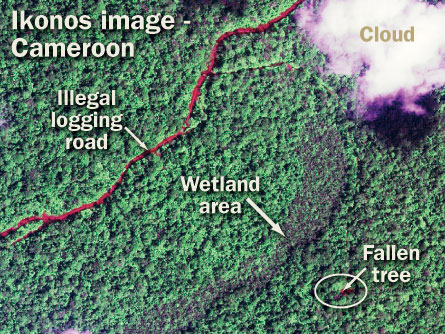Thwarting Tree Poachers
Earth’s tree cover helps store carbon dioxide and moderate ground temperatures. But society’s voracious appetite for wood products and cleared land has fostered rampant deforestation around the globe. Many trees are rapidly disappearing even from forests that are ostensibly protected by law. A new U.S. regulation that went into effect earlier this week has the potential to dramatically dampen trade in those poached trees.

The Lacey Act prohibits trade in protected species. When President William McKinley signed it into law 108 years ago, this anti-poaching statute — the nation’s oldest wildlife-protection regulation — covered only game and wild birds. Over the years, it has been extended to prohibit interstate or international importation of protected or illegally gained species. On Dec. 15, a new amendment went into effect that further extends the law’s reach; it now prohibits U.S. trade that aids and abets illegal logging.
Specifically, the new amendment makes it “unlawful to import, export, transport, sell, receive, acquire, or purchase in interstate or foreign commerce any plant, with some limited exceptions, taken, possessed, transported or sold in violation of the laws of the United States, a State, an Indian tribe, or any foreign law that protects plants.”
Admittedly, that’s quite a mouthful. But one primary intent of the law was to shut down illegal logging — especially overseas — by drying up the U.S. market for any resulting wood products (from lumber and furniture to paper). At a briefing this morning, World Resources Institute president Jonathan Lash noted that because no one can look at a piece of wood, much less wood chips or paper, and determine whether its parent tree had been harvested legally, the law puts the onus on mills and those who use wood products to ensure that none of their feedstock had been acquired illegally.
For instance, if a facility milled 1,000 trees, of which even a few had been harvested illegally, then all products from that mill would be prohibited access to U.S. markets. If shipments from such mills could be traced to a U.S. port or air strip, federal enforcement officials would have the right to seize the cargo and impose stiff fines on the exporters.
That’s in theory, anyway. WRI plans to test the new administration’s willingness to enforce the new law. And Lash offered a satellite image (above) that illustrates how forestry officials might start scouting scofflaws.
The photo shows a downed tree in Cameroon, located in a forest where no logging is permitted. Not far from the tree is a path to a road that goes directly from inside the forest to just one facility: a lumber mill.
Lash, a former prosecutor, argued with bountiful enthusiasm that this image offers prima facie evidence of activity now prohibited under the Lacey Act. The next step would be identifying products from that mill and their movement in trade.
“Imagine what happens if some environmental group makes the investment to track this along with partners on the ground,” he says. They could forward their images and documentation to the Justice Department, “which then sends the Coast Guard to swoop down on a container ship coming into the Port of Los Angeles.” So might begin a Lacey Act prosecution.
That has to happen just once or twice, Lash suspects, before major wood-products buyers in the United States — which is the world’s largest market for such goods — might start to “black list any company that is subject to prosecution under the Lacey Act. That would be a really neat way to begin changing what’s going on in [ill-protected] forests.”
“As with any new law, there’s always the question of the degree to which the U.S. government — the Department of Justice and U.S. Customs — is really going to enforce it,” observes Craig Hanson, deputy director of WRI’s People & Ecosystems Program here in Washington, D.C.
He says that Bush administration funding will only cover ”electronic declarations” under the new program: these are records on incoming shipments of wood products. Without allocating money for enforcement, Hanson says, “It’s like saying you have a police force when you’ve got a registration desk — but no beat cops.”
To test whether the revised Lacey Act has teeth, “WRI wants to work with some of our partners to launch an initiative where we leverage satellite technology and other investigative techniques,” Hanson says. Several successful prosecutions could prompt big headlines from Washington and Jakarta to Beijing, he says. “And they would reverberate throughout the forest-supply chain, pointing out that the U.S. government is finally taking [illegal logging] seriously.”
And the concern over illegal logging: It removes trees needed to fight global warming, compromises biodiversity and robs local economies of the taxes associated with legal trade. Indeed, Hanson notes, “it’s been estimated that developing countries lose $10 billion in revenues each year due to illegal logging. That’s money that could go towards their schools, infrastructure and economic development.”






